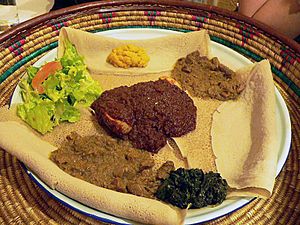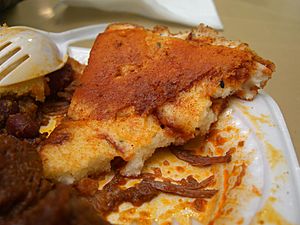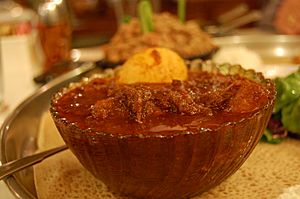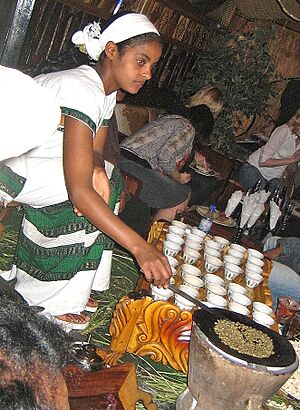Ethiopian cuisine facts for kids
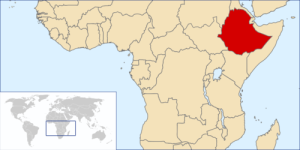
Ethiopian cuisine (Amharic: የኢትዮጵያ ምግብ "Ye-Ītyōṗṗyā məgəb") is famous for its tasty vegetable and often very spicy meat dishes. These dishes are usually served as wat, which is a thick stew. The stew is placed on top of injera (Amharic: እንጀራ), a large, soft, flatbread made from fermented teff flour. Injera is about 50 centimeters (20 inches) wide. Ethiopians often eat with their right hands, using pieces of injera to scoop up bites of the stews and side dishes.
The Ethiopian Orthodox Tewahedo Church has several fasting periods throughout the year, including all Wednesdays and Fridays. During these fasts, people do not eat any animal products like dairy or eggs. Because of this, Ethiopian cuisine has many delicious vegan dishes.
Contents
What is Ethiopian Food Like?
A typical Ethiopian meal has injera served with a spicy stew. This stew often contains beef, lamb, vegetables, or different types of beans like lentils. In some parts of Ethiopia, especially the Southern Nations, Nationalities and People's Region and the Sidama region, people also use the false banana plant (enset).
The enset plant is crushed and fermented to make foods like kocho, a bread-like food eaten with kitfo. The root of this plant can also be made into a hot drink called bulla, which is often given to people who are tired or sick. Another special dish from the Gurage people is coffee with butter. They also bake a bread called Kita herb bread.
Because Italy once occupied Ethiopia for a short time, pasta is also popular there, even in smaller towns. Coffee is a very important part of Ethiopian culture and food. After most meals, people have a special coffee ceremony where coffee is served.
Foods People Avoid
Ethiopian Orthodox Christians, Ethiopian Jews, and Ethiopian Muslims do not eat pork or shellfish. This is because their religions consider pork to be unclean. Many Ethiopians also choose to eat mostly vegetarian and vegan foods.
Main Ingredients
Berbere is a very important ingredient. It's a mix of powdered chili pepper and other spices like cardamom, fenugreek, coriander, cloves, ginger, nutmeg, cumin, and allspice. Berbere adds a lot of flavor to dishes like chicken stews and baked fish.
Another key ingredient is niter kibbeh. This is a special clarified butter that has been cooked with ginger, garlic, and other spices to give it a unique taste.
Mitmita (Amharic: ሚጥሚጣ) is a powdered seasoning that is orange-red. It contains ground birdseye chili peppers, cardamom seeds, cloves, and salt. Sometimes it also has cinnamon, cumin, and ginger.
During religious fasting periods, when animal fats are not allowed, Ethiopian cooks use different plant-based oils. These include sesame oil, safflower oil, and nug oil (also called "niger seed").
Popular Dishes
Wat
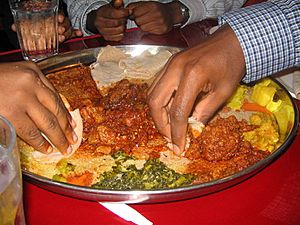
Wat is a stew that starts with a lot of chopped red onions cooked in a pot. Then, niter kebbeh (spiced butter) is added. For vegan dishes, vegetable oil is used instead. After that, berbere is added to make a spicy keiy wat. If they want a milder stew, they use turmeric instead of berbere, which is called alicha wat.
Wat can be made with different meats like beef, chicken, fish, goat, or lamb. It can also be made with Legumes like split peas and lentils, or vegetables like potatoes, carrots, and chard for vegan options.
The name of the wat usually tells you what's in it. For example, doro wat means chicken stew.
Tibs
Tibs (Ge'ez: ጥብስ ṭïbs) is a dish made by sautéing meat with vegetables. It can be spicy or mild, and have many or few vegetables. There are many kinds of tibs depending on how the meat is cut. Beef, mutton, and goat are the most common meats used.
Historically, tibs was served to show special respect to someone. Today, it is often prepared for special events and holidays.
Kinche
Kinche (Qinch’e) is a type of porridge that is a very common breakfast or supper in Ethiopia. It's simple, cheap, and healthy. It's made from cracked wheat, Ethiopian oats, barley, or a mix of these grains. It can be boiled in milk or water with a little salt. The main flavor comes from nit'ir qibe, which is spiced butter.
Oromo Dishes
The Oromos have many different vegetable and meat dishes. Like other Ethiopians, they do not eat pork.
- Foon Waaddii – roasted minced meat with special seasonings.
- Anchotte – a common dish in western Oromia.
- Baduu – the liquid left after milk is curdled and strained (like cheese).
- Maarqaa – a porridge made from wheat, honey, milk, chili, and spices.
- Chechebsaa – shredded biddena (a type of injera) stir-fried with chili powder and cheese.
- Qoocco – another type of kocho, common in western Oromia.
- Itto – a dish with various vegetables (tomato, potato, ginger, garlic) and lamb meat.
- Chukkoo – also called Micira; a sweet whole grain dish seasoned with butter and spices.
- Chororsaa – a common dish in western Oromia.
- Hulbata – a thick, slow-cooked stew made from fenugreek seed powder, potato, and lamb, seasoned with chili, garlic, and tomato. It's served on Biddena and is common in East and West Hararghe.
- Dokkee – a common dish throughout the Oromia state.
- Qince – similar to Marqaa but made from shredded grains instead of flour.
- Qorso (Akayi) – a snack in the Oromia state.
- Dadhii – a drink made from honey.
- Hanida/Haneed – a slow-roasted lamb dish usually served with rice.
- Shitney/Shatta sauce – a mix of herbs and peppers served with hanida.
- Farsho – a beer-like drink made from barley.
- Buna – coffee, which is very important.
Gurage Dishes
Kitfo

Kitfo (often spelled ketfo) is a special Ethiopian dish. It's made from raw (or very rare) minced beef. The beef is marinated in mitmita (a very spicy chili powder) and niter kibbeh (spiced butter). Gored gored is similar to kitfo but uses cubed beef instead of ground beef.
Ayibe
Ayibe is a mild and crumbly cottage cheese. It's similar in texture to crumbled feta. The liquid (whey) is drained from it. It's often served as a side dish to help cool down the spiciness of other foods. It doesn't have a strong taste on its own, but it can be mixed with mild or hot spices.
Gomen kitfo
Gomen kitfo is another dish from the Gurage people. Collard greens (ጎመን gōmen) are boiled, dried, and then finely chopped. They are served with butter, chili, and other spices. This dish is specially prepared for Meskel, a popular holiday celebrating the discovery of the True Cross. It's served with ayibe or sometimes even kitfo during a tradition called dengesa.
Sidama Dishes
Wassa
The enset plant (called wesse in the Sidamo language) is very important in Sidama cooking. After grinding and fermenting its root to make wassa, it's used in many foods.
Amulcho is an enset flatbread, used like injera to eat stews made from beef, mushrooms, beans, collard greens, or pumpkin.
Borasaame is a cooked mix of wassa and butter. It's sometimes eaten with Ethiopian mustard greens or beans. Traditionally, it's eaten by hand using a false banana leaf and served in a special ceramic pot called a 'shafeta'. A common version of borasaame uses maize flour instead of wassa and is called badela borasaame. Borasaame is usually paired with a seasoned yogurt drink called wätät. Both are common foods for funerals and the Fichee Chambalaalla festival, which is the Sidama new year.
Gomen ba siga
Gomen ba siga (ጎመን በስጋ, Amharic: "cabbage with meat") is a stew made of beef and Ethiopian mustard greens. It's served under a layer of amulcho.
Maize
Maize (also known as "corn") is a common crop in Sidama. It's often eaten as a snack with coffee. It can be ground into flour to make bread, roasted on the cob, or the kernels can be picked off to make bokolo, which is served either boiled or roasted.
Breakfast Foods
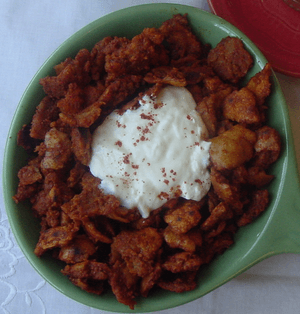
Fit-fit or fir-fir is a common breakfast dish. It's made from shredded injera or kitcha (a type of unleavened bread) stir-fried with spices or wat. Another popular breakfast food is fatira. This is a large fried pancake made with flour, often with a layer of egg, and eaten with honey.
Chechebsa (or kita firfir) looks like a pancake covered with berbere and niter kibbeh, or other spices. It can be eaten with a spoon. Genfo is a kind of porridge, which is another common breakfast dish. It's usually served in a large bowl with a hole in the middle filled with spiced niter kibbeh.
A type of ful, which is a fava bean stew with different toppings, is also common for breakfast. It's served with baked rolls instead of injera.
Snacks
Common Ethiopian snacks include dabo kolo (small pieces of baked bread similar to pretzels), or kolo (roasted barley sometimes mixed with other local grains). Kolo made from roasted and spiced barley, safflower kernels, chickpeas, or peanuts are often sold by street vendors in paper cones. People also enjoy snacking on popcorn and traditional lentil samosas.
Drinks
Atmet
Atmet is a drink made from barley and oat flour. It's cooked with water, sugar, and kibe (Ethiopian clarified butter) until it's a bit thicker than egg-nog. This sweet and smooth drink is often given to nursing mothers, but anyone can enjoy it.
Coffee
Many people believe that drinking coffee (buna) first started in Ethiopia. Coffee is a very important national drink and a big part of local business.
The coffee ceremony is the traditional way of serving coffee, usually after a big meal. It often uses a jebena (ጀበና), which is a clay coffee pot where the coffee is boiled. The person preparing the coffee roasts the beans in front of the guests, then walks around so everyone can smell the wonderful coffee scent. Then, the beans are ground using a traditional tool called a mokecha. The coffee is put into the jebena, boiled with water, and then served in small cups called si'ni. Coffee is usually served with sugar, but in some parts of Ethiopia, it's served with salt. Sometimes, niter kibbeh is added instead of sugar or salt.
Snacks like popcorn or toasted barley (kolo) are often served with the coffee. In most homes, there's a special coffee area decorated with fresh grass and special furniture. A full ceremony has three rounds of coffee (abol, tona, and bereka) and is accompanied by the burning of frankincense.
Tea (chai)
If someone doesn't want coffee, they will most likely be served tea. Tea is grown in Ethiopia in places like Gumaro and Wushwush.
Boiled coffee leaves
In southern Ethiopia, many groups drink boiled coffee leaves. It's called kuti among the Harari and kaari among the Majang. This drink is often made with different seasonings and spices like sugar, salt, rue, hot peppers, and ginger. The Ethiopian Food Safety Authority has even confirmed that coffee leaf infusions are safe to drink.
See also
 In Spanish: Gastronomía de Etiopía para niños
In Spanish: Gastronomía de Etiopía para niños


